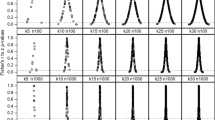Abstract
In 2017, a group of the leading mathematical statisticians published a paper-manifesto having an extremely simple sense: the common critical level of p-values should be decreased by an order of magnitude (0.005 instead of 0.05) (Benjamin, et al., 2017). In this review, the arguments of proponents and opponents of this proposal are discussed. Moreover, the problems related to the “reproducibility crisis” of the scientific results are considered. The corresponding argumentation cannot be understood without consideration of the fundamentals of the theory of statistical derivation. In this connection, the precise sense of some concepts, such as p-value, the Bayes factor, and the minimum a posteriori probability of the zero hypothesis are discussed in the review. This is made mainly with the examples related to the comparison of frequencies. It was shown that, when using p-values, particular attention should be paid to the comparison of low frequencies on the highly abundant samples. Some practical recommendations on application of the Bayes analysis are given.



Similar content being viewed by others
REFERENCES
Benjamin, D.J., Berger, J., Johannesson, M., Nosek, B., Wagenmakers, E., Berk, R., et al., Redefine statistical significance, Nat. Hum. Behav., 2018, no. 2, pp. 6–10.
Ioannidis, J., Why most published research findings are false, PLoS Med., 2005, vol. 2. e124.
Buck, S., Solving reproducibility, Science, 2015, vol. 348, no. 6242, p. 1403.
Kolmogorov, A.N., Probability theory, in Veroyatnost’ i matematicheskaya statistika. Entsiklopediya (Probability and Mathematical Statistics. Encyclopedia), Prokhorov, Yu.V., Editor-in-Chief, Moscow: Bol’shaya Rossiiskaya Entsiklopediya, 1999; Moscow: Drofa, 2003, pp. 874–875.
Melton, A.W., Editorial, J. Exp. Psychol., 1962, vol. 64, pp. 553–557.
Wasserstein, R.L. and Lazar, N.A., The ASA’s statement on p-values: context, process, and purpose, Am. Statistician, 2016, vol. 70, no. 2, pp. 129–133.
Lakens, D., Adolfi, F.G., Albers, C.J., Anvari, F., Apps, M.A., et al., Justify Your Alpha, 2018. psyarxiv.com/9s3y6.
Open Science Collaboration, Science. 2015, vol. 349, no. 6251, pp. 1–8.
McShane, B.B., Gal, D., Gelman, A., Robert, C., and Tackett, J.L., Abandon statistical significance, 2017. arXiv:1709.07588 [stat.ME].
Trafimow, D., Amrhein, V., Areshenkoff, C.N., et al., Manipulating the alpha level cannot 1 cure significance testing. comments on “Redefine statistical significance,” PeerJ. Preprints, 2017, vol. 5. e3411v1. https://peerj.com/preprints/3411/.
Perezgonzalez, J.D. and Frías-Navarro, M.D., Retract p < 0.005 and propose using JASP, instead, F1000Research, 2017, vol. 6, p. 2122.
Amrhein, V. and Greenland, S., Remove, rather than redefine, statistical significance, Nat. Hum. Behav., 2018, vol. 2, p. 4.
Esarey, J., Replication data for: lowering the threshold of statistical significance to p < 0.005 to encourage enriched theories of politics, Polit. Methodologist, 2017, vol. 24, no. 2, pp. 13–20. https://thepoliticalmethodologist.com/v24-n2-fix/.
Crane, H., Why “redefining statistical significance” will not improve reproducibility and could make the replication crisis worse, 2017. arXiv:1711.07801v1 [stat.AP].
Head, M.L., Holman, L., Lanfear, R., Kahn, A.T., and Jennions, M.D., The extent and consequences of p‑hacking in science, PLoS Biol., 2015, vol. 13, no. 3. e1002106.
Rubanovich, A.V. and Khromov-Borisov, N.N., Genetic risk assessment of the joint effect of several genes: critical appraisal, Russ. J. Genet., 2016, vol. 52, no. 7, pp. 757–769.
Wray, N.R., Yang, J., Hayes, B.J., et al., Pitfalls of predicting complex traits from SNPs, Nat. Rev. Genet., 2013, vol. 14, no. 7, pp. 507–515.
Goodman, S., A dirty dozen: twelve p-value misconceptions, Semin. Hematol., 2008, vol. 45, pp. 135–140.
Dienes, Z., How Bayes factors change scientific practice, J. Math. Psychol., 2016, vol. 72, pp. 78–89.
Held, L. and Ott, M., On p-values and Bayes factors, Annu. Rev. Stat. Appl., 2018, vol. 5, pp. 393–419.
Jeffreys, H., An invariant form for the prior probability in estimation “problems,” Proc. R. Soc. London, Ser. A, 1946, vol. 186, no. 1007, pp. 453–461.
Sellke, T., Bayarri, M.J., and Berger, J.O., Calibration of p values for testing precise null hypotheses, Am. Statist., 2001, vol. 55, pp. 62–71.
Funding
This work was supported by the Russian Foundation for Basic Research (project no. 16-06-0046517).
Author information
Authors and Affiliations
Corresponding author
Ethics declarations
The author declares that he has no conflict of interest. This article does not contain any studies involving animals or human participants performed by the author.
Additional information
Translated by M. Batrukova
Rights and permissions
About this article
Cite this article
Rubanovich, A.V. Redefining the Critical Value of Significance Level (0.005 instead of 0.05): The Bayes Trace. Biol Bull Russ Acad Sci 46, 1449–1457 (2019). https://doi.org/10.1134/S1062359019110086
Received:
Published:
Issue Date:
DOI: https://doi.org/10.1134/S1062359019110086



